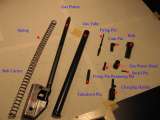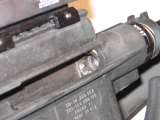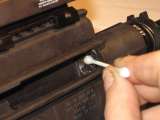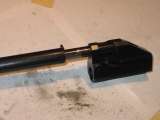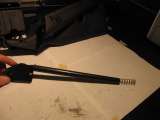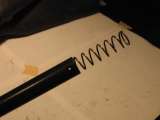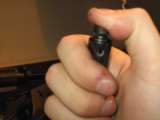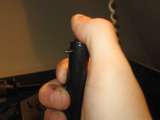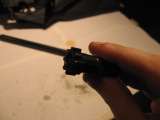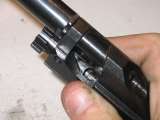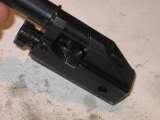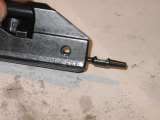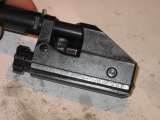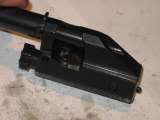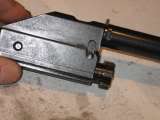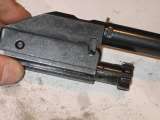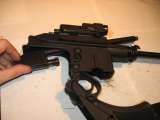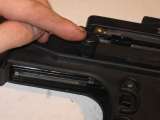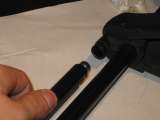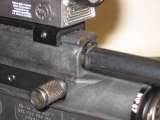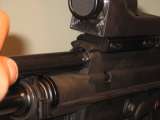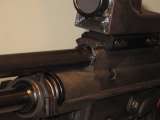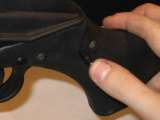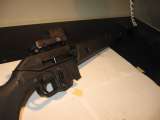Step 1: Ensure rifle is unloaded. Remove magazine, lock bolt to the rear. Verify that chamber is empty.
Also note that I bite my fingernails. It's been a habit for years. Oh well.
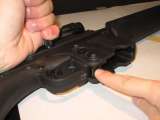
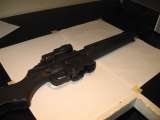
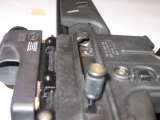
Step 2: Note the location of the takedown pin. It can be removed by pushing from either side using a cartridge, punch, pencil, or other small, thin object.
As a rule, I try to keep live ammunition away from my gun cleaning area in case the cartridge gets a mind of its own and decides to leap into the chamber on its own accord. I haven't actually had this happen yet, but better safe than sorry.
If you're field-stripping your rifle in the field or at the range, and you lack tools, a cartridge is a perfectly suitable means of removing this pin. I just don't like having live ammo around when I'm cleaning.
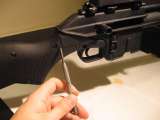
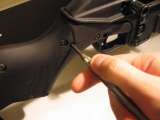
On the left side of the rifle where the gas system joins the receiver, you'll notice a small tab. First, close the bolt. Then grasp the gas tube, pull toward the front of the rifle, and rotate counterclockwise. When the tab reaches the vertical position, the gas system and bolt carrier will no longer be under spring tension.
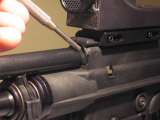
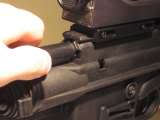
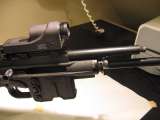
Lift up on the gas tube, which will drop the bolt carrier down through the bottom of the receiver. Remove the bolt carrier and gas tube as shown.
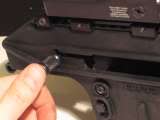
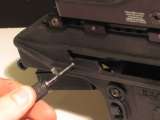
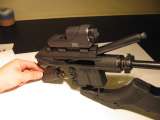
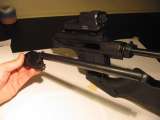
Tilt the bolt carrier so the firing pin falls out the rear. Remove the cam pin (indicated by my finger). After removing the cam pin, remove the bolt.
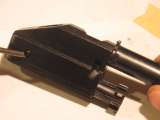
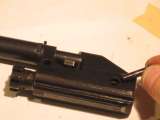
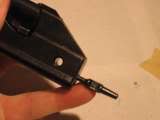
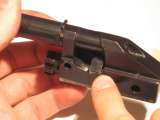
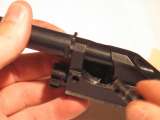
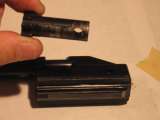
Turn the gas tube until you can see the small pin holding the piston head onto the piston. While grasping the tube firmly, use your thumb to restrain the piston head. Use the firing pin to gently drive out the small pin. While holding the head on, remove the firing pin and gently release the tension in the spring.
Remove the piston head, spring, and gas tube from the piston (the piston is a part of the bolt carrier).
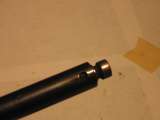
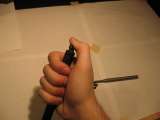
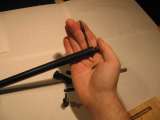
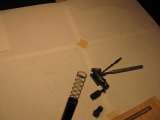
After all parts are thoroughly cleaned, wipe them all dry. Apply a light amount of oil to parts where metal-on-metal contact occurs, but do not oil the gas piston, piston head, inside of the gas tube, or spring.
Also, do not lubricate the firing pin or the firing pin channel inside the bolt carrier or inside the bolt. After cleaning these parts, ensure the pin and channel are completely dry -- gunk can build up quickly if oil remains, and can cause cause malfunctions or slamfiring.
Be sure to lightly lubricate the track that the cam pin slides in, the outside of the bolt itself, locking lugs, and the sides and bottom of the bolt carrier.
With use, you will note that some parts of the gun develop a bit of shiny spots where metal wears on metal. Give these areas a small bit of oil.
If you have cotton swabs or q-tips, soak the heads with solvent and clean the chamber and locking lugs around the chamber. It will be very difficult indeed to get this area perfectly clean. I generally don't consider perfect cleanliness in this area to be critical; I shoot dirty Wolf ammo, clean the chamber area and locking lugs as best I can, and have never experienced problems. AR-15 chamber cleaning brushes can be handy, if one has a flexible cleaning rod, but it's difficult to apply torque using a flexible rod. If anyone knows a more effective way of cleaning the chamber and locking lugs, let me know.
Be sure to lightly oil the external metal parts of the rifle, including the barrel and gas block (where the front handguard hinge attaches to).
Though usually not a problem, the gas block can sometimes become dirty and constrict the flow of gas to the piston, causing operating problems. If you wish, you can use a suitable pipecleaner (AR-15 gas tube pipecleaners are great, but are too long. Cut them with scissors to a more manageable length, and they work fine.) and a solvent to clean out the interior of the gas block. Be sure to remove all oil from the inside of the gas block, as oil will cause crud to build up...and that's exactly what you don't want happening.
Note on Lubrication
Only a light coating of oil is necessary. Excessive lubrication will attract residue during firing, and can cause failures. With CLP and other quality oils, one can apply the oil with a wet patch, and then gently wipe the metal with a dry patch to absorb excess oil. Really, only a thin film of lubrication is needed. If the oil is enough to move around with your fingers, it's probably too much.
Using Cleaning Rod to Clean Barrel
Using the cleaning rod, patches, bore brush, and solvent, clean the inside of the barrel. I've found using a solvent-soaked patch (run through 2-3 times), a bore brush (run down-and-back once for every 10 rounds fired), and then alternating dry and solvent-soaked patches until they come out clean works well. After bore is clean, run an oil-soaked patch through the barrel, then run a dry one through to remove excess oil. Only a very thin coat should remain.
Unfortunately, the design of the rifle requires that one clean the barrel from the muzzle end. This is generally not preferred, as it can push residue and solvent into the chamber. Using a boresnake can greatly simplify the process.
Using Boresnake to Clean Barrel
As an alternative to using a cleaning rod, one can use a boresnake. Soak the pre-brush cloth with a goodly amount of CLP, then drop the brass weight into the chamber and feed the string through the barrel and out the muzzle. Pull the snake through the barrel from the breech to the muzzle. I usually then run the snake through a second time, and the barrel's clean and ready to go. Easy, huh?
All right, now that the rifle's disassembled and cleaned, let's get on to reassembly!
